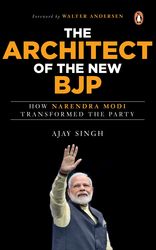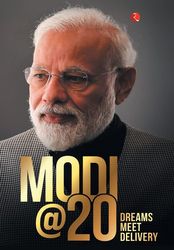Prime Minister Narendra Modi has hogged the limelight for two of the four decades of the BJP’s existence, first as chief minister, and then as one of the most powerful prime ministers in the country. Behind his electoral success is not only a Hindutva-infused charisma, but also a pragmatic mind which focused on building and remoulding the party organisation. This sets his tenure apart from that of the BJP's first prime minister, Atal Bihari Vajpayee, when the party was so focused on running the government that the organisation was neglected.
Modi's role in building the organisation through his innovative ideas and persistence in training the cadre has shaped a party which has captured the people's mind space, once dominated by the Congress. Senior journalist Ajay Singh brings out details of Modi's sharp skills in reshaping the party in his book, The Architect of the New BJP: How Narendra Modi Transformed the Party. Singh, who is currently press secretary to the president, provides a riveting account of Modi's journey as a quintessential organisation man who looked beyond conventions despite opposition from within and outside the party.
Modi's approach has often been viewed with skepticism, but five victories under his belt—thrice as chief minister and twice as prime minister—showed that he could read the pulse of the people and fashion his narrative accordingly. While there has been a spate of books on Modi's charisma and governance, this book provides a brilliant insight into how Modi made the BJP a formidable organisation.
Questions are often raised when the BJP brings leaders from political parties with whom there is little ideological synchronism. The party has gone ahead and rewarded these “eminent personalities” as they bring with them their support base and helps the organisation to penetrate new social bases and communities. The old-timers may scoff, but Modi sees an opportunity to grow. Many were surprised when Modi held Sneh Yatras and engaged with Pasmanda Muslims at the party's recent national executive meeting. But behind this is his decades-old experiments which made the party enter uncharted territories. As a party secretary, Modi insisted on alliances with former Congressmen Bansi Lal, and Sukh Ram in Haryana and Himachal Pradesh respectively, a strategy which was questioned then, but allowed the party to be accepted and grow exponentially in later years.
Unlike other political parties which enjoyed power, Modi's achievement has been to keep the government and party organisation together, and not at odds with each other. Singh says Modi believed that governance divorced from a robust party organisational structure was a sure recipe for disaster.
“The secret of Modi's success in groundbreaking methodological innovations is remarkable flexibility. Modi deployed unorthodox techniques, caring little for the old-fashioned dogmatic ways of expanding the organisation,” Singh writes.
It was Modi's insistence on building the organisation that helped him survive many crises, including demonetisation, the lockdown during the pandemic, and the farmers' agitation.
The insightful book also charts Modi's growth from a behind-the-scenes strategist to an orator and an able administrator. Modi's emerged as a fiery orator after the 2002 Gaurav Yatra. It was during this yatra that he started the yes-no style of engagement with the people, which he continues till today. The book is essential reading for those interested in understanding the rise of the BJP, its remake, and how it adapted to the diversity of the country's polity and captured the mind space. It will even provide insights to parties opposed to the BJP on what to do to stay politically relevant.
The Architect of the New BJP: How Narendra Modi Transformed the Party
By Ajay Singh
Published by Penguin Vintage
Price Rs599; Pages 168
***
THE YEAR WAS 1987. Amit Shah, then a 23-year-old state unit secretary of the BJP, was thinking of ways to grow his party in Gujarat. A new party general secretary (organisation) had joined, and he had an idea. The plan was simple: the party had to grow from the bottom. Every village was likely to have two major candidates who has contested the previous sarpanch elections. The winner would invariably be from the Congress or the Janata Dal, and the runner-up would be sidelined and forgotten. Shah was asked to target this runner-up as part of the party membership drive. “The rationale was razor-sharp as the loser in an election would still have 30-40 per cent votes. It gave us a notable micro-level leader of influence,” says Shah.
This was the first time Narendra Modi and Amit Shah had worked together, and it is a model the BJP follows to this day.
The book Modi@20—a collection of 21 essays by domain experts, intellectuals and close associates—brings out such details about the current prime minister’s contributions, largely from the time he first became chief minister of Gujarat in 2001.
Shah, for instance, writes about how Modi changed political grammar. “He turned membership drives [into] festivals, called the party a mother, and the manifesto, mother’s word,” writes the home minister.
In his article, Foreign Minister S. Jaishankar recalls how Modi had little appetite for conventional sightseeing on foreign visits, and instead zoned in on best practices that could be replicated back home. As examples, he puts forth bullet trains, cleaning of rivers and affordable housing.
National Security Advisor Ajit Doval talks about how Modi dealt with the ongoing border standoff in Ladakh. “While we reacted in a particular way, there were other options. Some were exercised and some more will be exercised, if vital and major interests of the country are at stake. Peace is our strength, not our weakness,” Doval writes, quoting Modi.
On the cultural front, author Amish Tripathi writes, “Modi wears his cultural pride on his sleeve, and he never misses an opportunity to showcase India’s culture to visiting dignitaries.”
In the other essays, psephologist Pradeep Gupta outlines Modi’s connection with the masses, former NITI Aayog vice-chairman Arvind Panagariya writes about Modi’s delivery model and key welfare schemes, industrialist Uday Kotak looks at Modi’s encouragement of entrepreneurs and their role in nation building, surgeon Devi Shetty writes on the handling of the pandemic, Infosys co-founder Nandan Nilekani praises Modi’s digital transformation through Aadhaar and digital payments and Olympic medallist P.V. Sindhu talks about Modi’s exemplary encouragement to the youth.
The book, promoted by the government, is an authoritative source on everything Moditva.
Modi@20, Dreams Meet Delivery
Published by Rupa
Price Rs895, Pages 439



